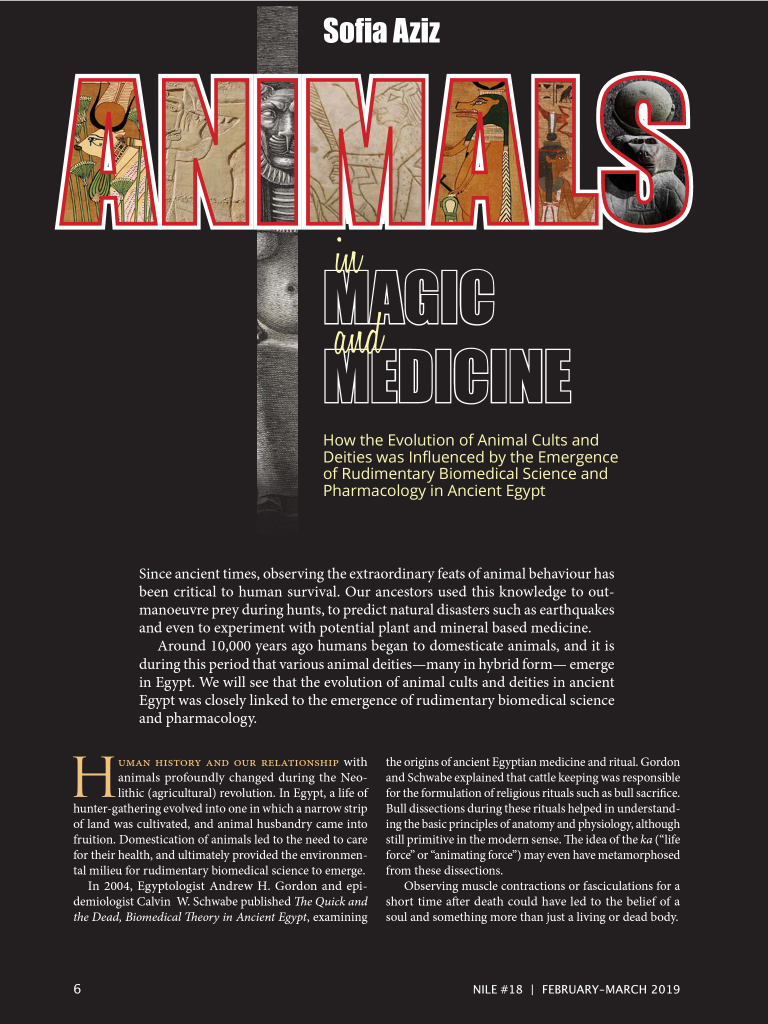Since ancient times, observing the extraordinary feats of animal behaviour has been critical to human survival. Our ancestors used this knowledge to out manoeuvre prey during hunts, to predict natural disasters such as earthquakes and even to experiment with potential plant and mineral based medicine. Around 10,000 years ago humans began to domesticate animals and it is during this period that various animal deities, many in hybrid form emerge in Egypt. We will see that the evolution of animal cults and deities, in ancient Egypt, was closely linked to the emergence of rudimentary biomedical science and pharmacology.
Human history and our relationship with animals profoundly changed during the Neolithic (agricultural) revolution. In Egypt a life of hunter gathering evolved into one in which a narrow strip of land was cultivated and animal husbandry came into fruition. Domestication of animals led to the need to care for their health thus providing the environmental milieu for rudimentary biomedical science to emerge. Gordon and Schwabe in their book ‘The Quick and the Dead, Biomedical Theory in Ancient Egypt, 2004’ explain that cattle keeping was responsible for the formulation of religious rituals such as bull sacrifice. Bull dissections during these rituals helped in understanding the basic principles of anatomy and physiology, although still primitive in the modern sense. The idea of the ‘ka’ (soul/spirit) may even have metamorphosed from these dissections. Observing muscle contractions or fasciculations for a short time after death, according to Gordon and Schwabe, could have led to the belief of a soul and something more than just a living or dead body. They elaborate on this theory by stressing the bull’s forelimb was the first to be removed, and in a state of muscle spasm was hurriedly used in the opening of the mouth ceremony as part of the revivification ritual. They provide several examples in support of this theory including an inscription in the sixth dynasty tomb of Khentika: ‘Let the foreleg come away, hurry up.’ Ka incidentally was also the name for bull and Gordon and Schwabe, think it likely, that the ka sign signifies the bull’s two horns. The bull could even be one of the earliest animals to be associated with divinity in ancient Egypt. The Apis bull, recognised by specific markings, became hugely important in the Memphis region and its cult emerged as early as the first dynasty, although the ideological representations of it as a divinity probably began earlier.
But what is a less known intriguing fact about some animals is their remarkable ability to self medicate and how observing this could have led humans to turn to nature’s pharmacy for health care. This is a fascinating area of research and even the esteemed Naturalist and Broadcaster Sir David Attenborough has appeared in several documentaries which have filmed animals in the wild self medicating by using plants to cure a number of ailments. Animals such as capuchin monkeys have even been observed manically rubbing pungent plants all over themselves; incredibly, the pungent chemical repels insects and keeps the animals free from unpleasant bites. Our ancestors witnessed this extraordinary behaviour and documented accounts of animals self medicating survive from ancient Greece and Rome. Living in settlements with a growing population meant disease and death was rampant therefore discovering the medicinal use of plants and minerals was a major breakthrough for early societies. The Egyptian pharmacopoeia came to consist of drugs of mineral and vegetable origin. Minerals such as clay, copper, granite, gypsum, lapis lazuli, Nile mud, and natron were utilised and herbal remedies, for instance, included acacia, coriander, date, hemp, juniper, linseed, moringa, onion, willow and wormwood. Incantations and spells invoking the assistance of a number of gods were also included in the medical papyri.

Nile Magazine #18 Feb-March 2019 to read more of my article.